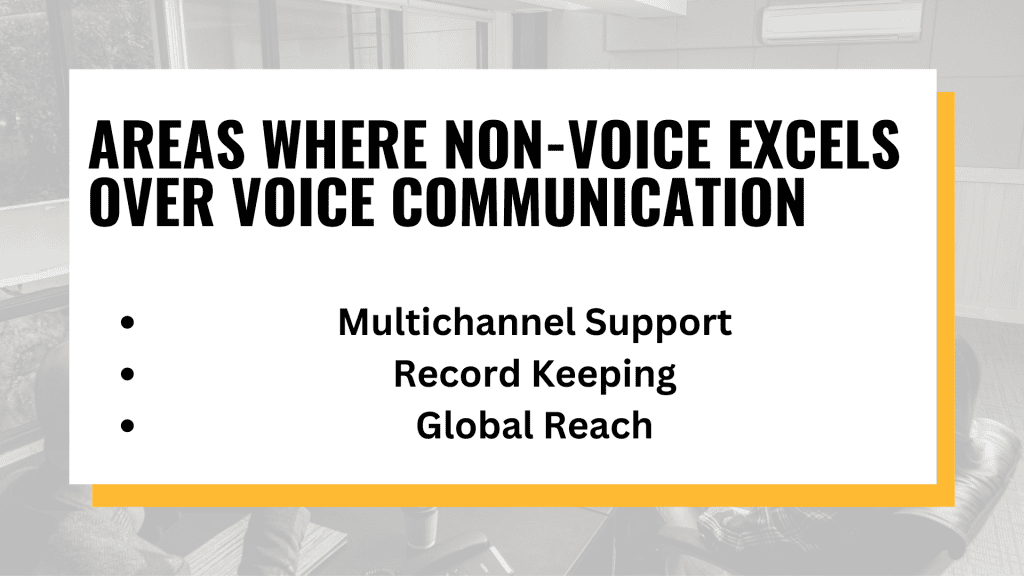Voice vs Non-Voice Trends are reshaping the landscape of customer service and call center operations. In this rapidly evolving sector, understanding the difference between Voice Support and Non-Voice Support is crucial for businesses aiming to optimize their customer experience. Voice Support, primarily through call centers, offers direct, real-time interaction, leveraging technologies like interactive voice response and voice recognition software. It excels in delivering personalized, immediate assistance, contributing significantly to customer satisfaction. Conversely, Non-Voice Support, encompassing email, chat, and social media interactions, is gaining traction. This mode of communication, powered by AI Technology and chatbot advancements, offers flexibility and convenience. It’s particularly effective in handling routine inquiries, allowing for multitasking and documentation. Non-Voice Support systems are integral in omnichannel communication strategies, ensuring a seamless customer experience across various platforms.
Automation plays a pivotal role in both voice and non-voice services. With advancements in artificial intelligence in customer service, including natural language processing and machine learning, businesses are increasingly adopting automated customer support systems. These technologies enhance call center efficiency, reduce operational costs, and improve response times.
The trend towards Business Process Outsourcing (BPO) in both voice and non-voice sectors is evident. Outsourcing enables companies to access specialized skills and technology, often at a lower cost. Multichannel Support, integrating voice and non-voice channels, is becoming a standard in customer service, ensuring a comprehensive customer experience.
Voice vs Non-Voice Trends also involves a significant investment in technology. Voice service analytics, speech analytics, and voice-activated technology are transforming voice support, making it more efficient and customer-friendly. Non-voice communication trends, on the other hand, are leaning towards digital transformation in support, with a focus on emerging trends in communication like chatbots and AI-driven support systems.
Boost Voice refers to the increasing reliance on voice-activated technology and interfaces, such as smart speakers and voice assistants. This trend is driven by the convenience and speed of using voice commands for various tasks. On the other hand, Non-Voice Trends involve text-based or touch interactions with technology, like typing on keyboards or using touchscreens. While voice technology is growing rapidly due to improvements in natural language processing and artificial intelligence, non-voice methods continue to be prevalent for tasks requiring precision or in environments where speaking aloud is not feasible. Voice and Non-Voice trends coexist, catering to different needs and preferences.
The Rise of Voice Technology
Voice technology has significantly transformed how we interact with our devices and services, offering a hands-free, efficient, and often more natural way of communication. With the rapid advances in voice recognition and AI-driven communication, it’s essential to understand the evolving landscape of voice vs non-voice trends, particularly in the context of customer service and business operations.
Key Players and Products Shaping the Voice Technology Landscape
Big names like Amazon’s Alexa, Google Assistant, and Apple’s Siri have dominated the voice technology space, leading the way in how voice support is integrated into our daily lives. These products are not just personal assistants; they’ve become integral in driving forward voice service analytics and voice search optimization. Similarly, companies are increasingly adopting voice technology for customer interaction, leveraging automated customer support and interactive voice response systems to enhance customer experience.
Voice vs Non-Voice Trends in Customer Service and Call Center Operations
The trend towards voice technology in customer service is clear. Voice support offers immediacy and ease, allowing for more natural interaction. However, non-voice support systems like email, chat, and social media remain vital, offering detailed, asynchronous communication options. Modern call centre efficiency relies heavily on a blend of both, ensuring a multichannel support strategy that caters to various customer preferences. The emergence of omnichannel communication signifies a shift towards integrating voice and non-voice support, aiming for a seamless customer experience.
Benefits and Challenges of Adopting Voice Technology
Voice technology brings numerous advantages, including faster response times, improved accessibility, and a personalized user experience. Especially in business process outsourcing, incorporating voice support can lead to more efficient customer service solutions. However, challenges remain, such as ensuring the technology understands different accents, languages, and colloquialisms, as well as maintaining privacy and security.
Outsourcing and Its Role in Voice vs Non-Voice Support
Outsourcing is a critical strategy for many businesses looking to improve their customer service operations. Affordable voice vs non-voice solutions are often sought after in business process outsourcing. Companies must weigh the voice vs non-voice cost analysis, considering the impact of AI on voice services and the benefits of non-voice over voice services for specific customer segments.
Integration of AI Technology and Automation in Voice Services
AI technology and automation are at the forefront of enhancing both voice and non-voice customer support. Artificial intelligence in customer service, particularly through machine learning in telecom and speech analytics, is revolutionizing how businesses understand and meet customer needs. Chatbot advancements and voice recognition software are becoming more sophisticated, offering more human-like and efficient customer interactions.
Navigating Communication Trends for Optimal Customer Experience
The ultimate goal of integrating voice and non-voice support strategies is to optimize customer experience. Digital transformation in support services means businesses must stay abreast of emerging trends in communication, including the rise of voice-activated technology and the growth of non-voice communication platforms. Implementing best practices in voice support and continually improving non-voice customer interaction is key to staying competitive and meeting customers’ evolving expectations.
Non-Voice Communication: Still Holding Ground
In the realm of customer service and operational efficiency, the debate between voice and non-voice trends continues to be a topic of relevance. Non-voice communication, encompassing mediums such as email, texting, and social media messaging, remains a pivotal aspect of business operations, particularly in areas where it excels over voice communication. This discussion will delve into the continued relevance of non-voice communication, the arenas where it outperforms voice communication, and provide an overview of leading non-voice communication platforms and tools.
Continued Relevance of Non-Voice Communication
The relevance of non-voice communication in today’s business landscape is underscored by its adaptability and efficiency. Non-voice support, as part of a broader Business Process Outsourcing (BPO) strategy, offers significant advantages including documentation ease, accessibility, and a generally lower cost structure than voice support. The voice vs non-voice trends in Customer Service indicates a growing preference for digital and written communication channels, especially among millennials and Gen Z consumers who favour texting and social media interaction.

Areas Where Non-Voice Excels Over Voice Communication
Non-voice communication shines in several key areas compared to its vocal counterpart:
- Multichannel Support: Non-voice channels provide customers with the flexibility to choose their preferred method of communication, enhancing the overall Customer Experience.
- Record Keeping: Written communications are easily documented for future reference, facilitating better Call Center Operations and compliance.
- Global Reach: Overcoming language barriers is often more manageable with written communication, essential in global business settings.
Incorporating AI Technology and Automation, such as chatbot advancements and interactive voice response systems, non-voice channels are continually improving, offering sophisticated customer interactions that were once only possible through direct human engagement.
Overview of Leading Non-Voice Communication Platforms and Tools
Several platforms and tools lead the way in non-voice communication, offering robust solutions for businesses seeking to enhance their customer interaction while aligning with communication trends. Notable among these are:
- Chatbots and AI-Powered Platforms: Leveraging machine learning and natural language processing, these tools offer real-time customer support without human intervention.
- Email and Social Media Management Tools: Platforms specializing in managing large volumes of emails and social media interactions streamline communication and ensure timely responses.
- CRM Systems: Customer Relationship Management systems often have built-in non-voice support features, allowing for efficient communication tracking and management.
Comparative Analysis: Voice vs Non-Voice
In the digital age, businesses continuously seek efficient ways to handle customer service, leading to a comparative analysis of Voice vs Non-Voice Trends in communication. This comparison is crucial as companies decide on implementing voice support, non-voice support, or a combination of both in their customer service and call center operations. The decision between these two hinges on various factors including technology, customer preference, and the nature of the business itself.
Voice communication, often associated with traditional call center operations, is known for its personal touch and effectiveness in handling complex customer queries. It leverages tools like interactive voice response and voice recognition software to enhance customer service. On the other hand, non-voice support, encompassing email, chat, and social media, is gaining traction for its efficiency and 24/7 availability. It includes advanced solutions like chatbot advancements and automated customer support, powered by artificial intelligence in customer service and natural language processing.
Businesses leveraging voice support emphasize the need for a personal connection, often beneficial in industries like healthcare or financial services where complex and sensitive issues are discussed. Non-voice support is preferred for its multitasking capabilities and is often employed in IT support, order processing, and other areas where written documentation is beneficial. The use of business process outsourcing (BPO) for both voice and non-voice services allows companies to provide round-the-clock customer service efficiently and cost-effectively.
Several case studies highlight the successful integration of voice and non-voice communication. A notable example is a multichannel support approach where a retail company employs chat for quick queries and phone support for in-depth product discussions.
The current trend leans towards a blend of both, with businesses employing an omnichannel approach to provide a comprehensive customer experience. This involves integrating various communication channels — voice calls, emails, chat, and social media — to create a unified customer service front. Such integration is supported by advanced communication technology, including omni-channel communication platforms and machine learning in telecom.
Industry Adoption and Consumer Behavior
The integration of voice and non-voice communication in various industries reflects a significant shift in consumer preferences and behavior patterns. Understanding the impact of demographic and regional factors on these trends is crucial for businesses to adapt and thrive.
Industry Adoption of Voice and Non-Voice Communication
Industries worldwide are increasingly embracing both voice and non-voice communication methods. In customer service, the use of Voice Support and Non-Voice Support is becoming more nuanced. Call Center Operations are now leveraging both approaches to enhance Customer Experience. For instance, in sectors like retail and banking, voice communication remains predominant for complex customer queries due to its personal touch and efficiency. Meanwhile, industries like IT and e-commerce are increasingly relying on non-voice channels such as emails and chatbots, acknowledging their convenience for consumers.
Automation and AI Technology are playing pivotal roles in this integration. Automated customer support systems, including chatbots and Interactive Voice Response (IVR) systems, are becoming more sophisticated. This adoption is not just about replacing human agents but enhancing their capabilities to provide Multichannel Support.
Changing Consumer Behavior and Preferences
The shift towards non-voice channels signifies changing consumer behavior. Today’s consumers value quick and efficient service. They prefer text or messaging services for simple queries, reserving voice calls for more complex issues. This preference is reflected in the growing popularity of Non-Voice Support systems. The trend is also visible in demographic and regional analyses, where younger generations and tech-savvy regions show a greater inclination towards digital communication methods.
Voice vs Non-Voice Trends: Impact of Demographics and Regions
Demographic factors play a crucial role in shaping Voice vs Non-Voice Trends. Younger demographics, who are more comfortable with technology, often favor non-voice communication for its convenience and speed. In contrast, older demographics may still prefer voice communication for its personal touch and simplicity.
Regionally, the adoption of voice and non-voice communication varies. In areas with high digital literacy, non-voice methods like chat and email are more prevalent. In contrast, regions with lower digital access still rely heavily on traditional voice communication. This variation necessitates a tailored approach for businesses, especially in sectors like Business Process Outsourcing and telecom, to address diverse customer needs effectively.
Conclusion
In the evolving landscape of communication, businesses and individuals must carefully consider the dynamic between Voice vs Non-Voice Trends. Voice Support and Non-Voice Support are becoming integral in Customer Service, especially within Call Center Operations. The advent of Automation and AI Technology has significantly influenced these sectors, leading to diversified Communication Trends.
For businesses, adopting Business Process Outsourcing, particularly in Multichannel Support, can dramatically enhance Customer Experience. Voice vs Non-Voice Trends indicate a shift towards a more integrated, omnichannel approach. Outsourcing can be a strategic move to incorporate these trends efficiently into operations.
When considering Voice vs Non-Voice Trends, such as Automated Customer Support, Interactive Voice Response, and Chatbot Advancements. These technologies align with voice recognition software and non-voice support systems, marking a substantial shift in omnichannel communication and artificial intelligence in customer service.
For an effective communication strategy, incorporating natural language processing and machine learning in telecom is vital. Voice Service Analytics and Non-Voice Communication Trends are guiding businesses towards customer experience optimization and digital transformation in support. Voice Search Optimization and Speech Analytics are also pivotal in understanding and leveraging Voice Activated Technology.
Adopting affordable voice vs non-voice solutions, understanding the impact of AI on voice services, and exploring emerging non-voice communication platforms are long-tail strategies businesses should consider. Voice vs Non-Voice cost analysis and voice vs non-voice customer satisfaction rates provide valuable insights for making informed decisions.
FAQs
What are voice vs non-voice trends?
Voice trends involve the growing use of spoken interactions through devices like smartphones, voice assistants, and call centers. Non-voice trends include text, email, live chat, and social media interactions. Both are evolving with technology, with voice incorporating more AI and natural language processing, and non-voice expanding with automated and real-time messaging options.
How do voice services differ from non-voice services?
Voice services involve real-time spoken interaction, typically via telephone or voice assistants. Non-voice services encompass written or typed communication like emails, text messages, or chats. Voice services are often preferred for complex or urgent issues, while non-voice is favored for convenience and documentation.
What are the benefits of non-voice support?
Non-voice support offers several benefits including 24/7 availability, convenience for users to multitask, written records of interactions, and often faster resolution as multiple queries can be handled simultaneously. It’s also typically less costly to implement and maintain compared to voice support.
Can voice and non-voice services be integrated?
Yes, voice and non-voice services can be integrated to provide a seamless customer experience. Many businesses use omnichannel approaches, allowing customers to switch between voice calls, text, and other mediums without losing context. Integration can improve efficiency and customer satisfaction.
What technologies are driving changes in voice services?
Technologies driving changes in voice services include AI, machine learning, natural language processing, and voice recognition. These technologies enable more accurate voice assistants, improved customer interaction through speech analytics, and personalized experiences.
How is AI impacting non-voice customer service?
AI is revolutionizing non-voice customer service by enabling chatbots and virtual assistants that can understand and respond to customer queries, provide personalized recommendations, and automate routine tasks. AI helps in analyzing customer data for better service and supports agents with real-time information.
What are the challenges of implementing voice support?
Challenges of implementing voice support include the need for robust and accurate speech recognition, handling diverse accents and languages, ensuring privacy and security, integrating with existing systems, and providing consistent quality across different devices and platforms.
How can businesses choose between voice and non-voice services?
Businesses should consider customer preferences, the nature of their services, available resources, and the complexity of queries when choosing between voice and non-voice services. A mix of both, tailored to specific customer needs and journey stages, often works best.
Are non-voice services more cost-effective than voice?
Non-voice services can be more cost-effective than voice, as they generally require less human intervention, can handle multiple interactions simultaneously, and reduce the need for extensive telephony infrastructure. However, the actual cost-effectiveness depends on the specific implementation and scale of operations.
What future trends are expected in voice and non-voice services?
Future trends in voice and non-voice services include increased integration and seamlessness between the two, greater personalization through AI and machine learning, more sophisticated self-service options, and the continued rise of omnichannel communication strategies. Expect both to evolve with advancing technologies and changing consumer behaviors.






